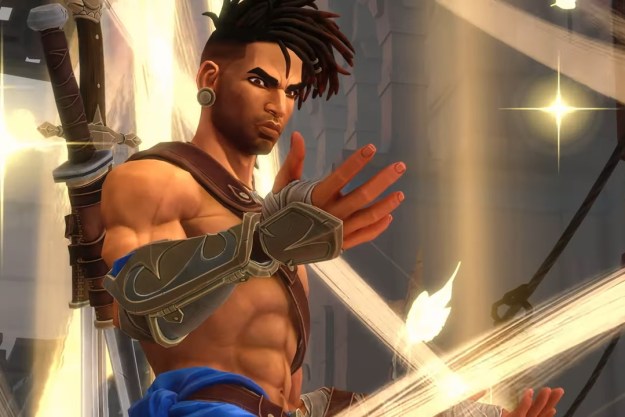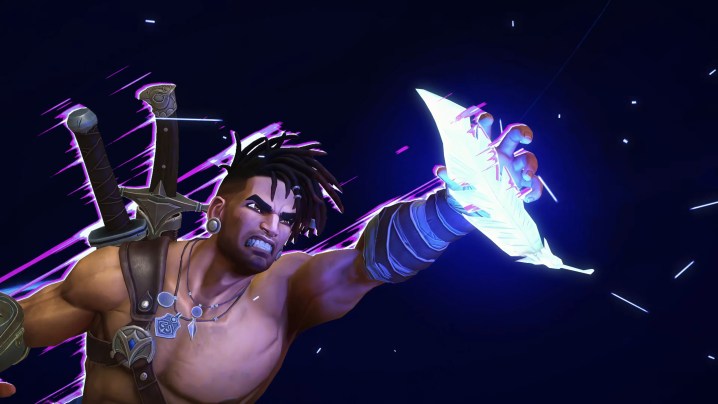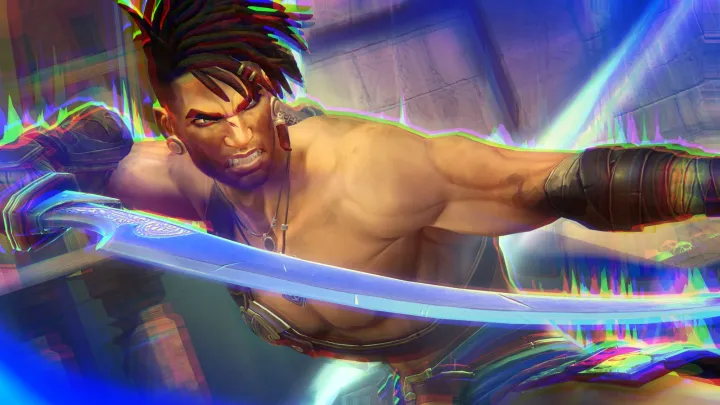
“Prince of Persia: The Lost Crown is a monumental achievement in approachable, seamless Metroidvania design.”
- Insightful character moments
- Seamless Metroidvania design
- Fluid platforming and combat
- Innovative Memory Shard system
- Lots of accessibility options
- Overcrowded cast of characters
In Prince of Persia: The Lost Crown, even the tutorials are fun.
A couple of hours into Ubisoft’s riveting 2D adventure, the heroic Sargon arrives at The Haven. Nestled in the middle of the large interconnected map, this place serves as a hub for all of The Lost Crown’s most important vendors. One such character taking residence here is Artaban, a fellow Immortal helping Sargon on his quest to find the kidnapped prince. Artaban decides to help Sargon understand and refine his combat abilities as he slowly explores every nook and cranny of Mount Qaf. Artaban’s challenges serve as basic tutorials for systems like parrying and air juggling, but the banter interspersed between those tutorials proves to be valuable insight into each character.
By doing this, Prince of Persia: The Lost Crown earns engagement in something gamers usually have to slog through. Completing these challenges made me care deeply for Sargon and Artaban, all while making me a better player. It serves as a microcosm of what Prince of Persia: The Lost Crown does so well: taking tried-and-true game design elements and making them utterly captivating.
Prince of Persia: The Lost Crown is the best Metroidvania since 2021’s Metroid Dread. It sticks to the rewarding style of exploration that makes this genre great while ensuring that experience is as seamless as possible thanks to the innovative Memory Shards system and helpful Guided Mode option. All of that is held up by a backbone of silky smooth platforming and combat that’s as easy or difficult as you want it to be.
A lot of lore
Prince of Persia: The Lost Crown follows Sargon, a member of the Immortals, who serve as Queen Thomyris’ champions in battle. Led by regal-looking warrior Vahram and taught by the cunning Anahita, this group of seven warriors feels unstoppable in The Lost Crown‘s action-packed intro. One betrayal later, Sargon finds himself hunting down the kidnapped prince Ghassan, who has been taken to Mount Qaf. That place contains the ruins of the previous King’s empire and time flows oddly here. That only scratches the surface of the narratively loaded adventure.

My main qualm with the otherwise excellent adventure is its narrative bloat, especially in its opening. It introduces so many characters so quickly that it’s hard to care much when one character betrays the group and kidnaps Prince Ghassan because you barely know either of them. Metroidvania narratives tend to be best when they say less and show more, but early on, The Lost Crown attempts to explain it all. In that way, it feels like a sequel to a Prince of Persia game that doesn’t exist, as this is the franchise’s first game in years and a complete reboot of the series that doesn’t require knowledge of any previous titles.
Thankfully, this issue resolves itself over time. Through smaller, more personal moments with characters like Sargon, Artaban, and Vahram, I came to care more about their struggles and found more subtle and well-scripted moments as the story progressed.
As a bonus, I also appreciate how it approaches telling a story about multiple timelines. Thankfully, it doesn’t fall into zeitgeisty multiverse ideas that have grown tiresome in media over the past few years. Even if you don’t love The Lost Crown’s story, it’s a minor part of a much grander Metroidvania game, one of the best ones I’ve played in years.
Metroidvania done right
If you’ve played a Metroidvania before, whether they be more hardcore titles like Hollow Knight or lighthearted affairs like Disney Illusion Island, you’ll recognize the basic structure of The Lost Crown. Mount Qaf is made up of several biomes, all of which lead into each other and are full of interconnected rooms. Access to certain paths is linear at first, but as Sargon obtains new abilities, more paths open up, enabling story progression and adding unexplored depth to previously visited areas. On a surface level, The Lost Crown nails its world design; each room has a clear sense of place within the wider setting of Mount Qaf, and most of them have a secret or two that make them worth revisiting later in the adventure.

It’s a beefy Metroidvania too; it took me 20 hours to complete the main story, and even then, I’d only discovered about 70% of the game’s content overall, according to in-game data. Story progression is the main purpose for exploration, but The Lost Crown rewards players who explore and take on challenges with optional boss fights, sidequests that add more personality to this game’s world, various currencies, combat modifying amulets, and more. When I unlocked new abilities (like a double jump), I always took the time to revisit some older areas and see what new secrets I could uncover with those powers. That’s one of the biggest compliments I can give a Metroidvania.
Part of why I did that is because The Lost Crown offers gameplay systems that make exploration seamless. When the adventure begins, players can choose between an Exploration Mode, which gives less information to players about where they need to go next and what paths they can potentially open with their new abilities, and a more informative Guided Mode. For most of my playtime, I stuck with Exploration Mode, and The Lost Crown’s world design and in-game hint system were intuitive enough that I rarely felt lost or unsure of where to go next.
This is a quest Ubisoft Montpellier wants players to see through to the end.
At the start of a new play session, I would briefly turn on Guided Mode in the options menu to realign by bearings and gain a general idea of where to head. Another helpful tool that makes it easy to pick up where I left off is Memory Shards. By pressing down on the D-pad at any time, I can take a screenshot and pin it to my map. Often, I did so for puzzles or platforming challenges I knew I couldn’t complete yet. The innovative feature is a godsend for a sprawling Metroidvania like The Lost Crown, as a Memory Shard presents a much clearer picture for why the player needs to return to a place than a random marker placed on the map (which The Lost Crown also has if you prefer that system). It’s such a handy tool that I hope to see in more Metroidvania games going forward.
No matter how often you tweak difficulty, place Memory Shards, and enable Guided Mode or the Platforming Assist that skips over some tougher obstacle courses, The Lost Crown doesn’t punish or reprimand players for using them. Accessibility and difficulty options are thorough and highly customizable, so while Mount Qaf may seem intimidating at first, this is a quest Ubisoft Montpellier wants players to see through to the end.
Great on Nintendo Switch
Memorable characters and captivating Metroidvania design alone make The Lost Crown a must-play, but the excellent combat and platforming help bring this adventure to another level. The development team’s roots in games like Rayman Origins and Legends shine in the platforming, which finds creative ways to combine all of Sargon’s tools. A particularly memorable midgame set piece had me following giant insects as they destroy parts of a sand-filled temple. I jump through those open sections, dodging deadly spikes that adorn the walls.
The Lost Crown is a great fit for Nintendo Switch.
The Platforming Assist accessibility option will get you through story-required platforming challenges, but it doesn’t apply to many of the hidden optional rooms that provide some of the most difficult moments. At times, the platforming reminds me of Celeste, perhaps because air dashing and wall jumping are major components. That’s a big game for The Lost Crown to live up to, but Ubisoft’s latest holds its own against genre greats, even when played on a system full of them like Nintendo Switch.
Intricate, fast-paced platformers like this need to run smoothly, so I was initially worried about trying The Lost Crown on Nintendo Switch. Thankfully, Ubisoft proved once again that it makes some of the best-performing games on the platform. The Lost Crown consistently runs at a stable frame rate in docked and handheld mode. I only saw some minor drops during a couple more graphically intensive cutscenes.

The only significant glitch I encountered caused the first boss’ arena to disappear during the fight, but that quickly resolved itself after I died and didn’t hamper my enjoyment of the overall game much. The Lost Crown is a great fit for Nintendo Switch, although you may want to use a Pro Controller if you don’t like the Joy-Cons triggers; this game uses them a lot for dodging and parrying.
Don’t forget to parry
Combat can sometimes feel out of place in platformers, but it’s harmoniously handled here. Sargon’s basic three-hit combo deals with most enemies, but has hidden depth like air juggling combos and attacks based on directional inputs. Amulets obtained throughout the adventure can add even more skills, like a parry that slows time, while many of Sargon’s platforming abilities also see use in battle. A teleport ability, where Sargon leaves a copy of himself mid-action to quickly move back to, can make a three-hit combo into a six-hit or more combo if used correctly.

Following in the footsteps of games like Hollow Knight and Sekiro: Shadows Die Twice, the key to “getting good” at combat in The Lost Crown is learning to master the parry and dodge. Those techniques quickly became my best friends as I bobbed and weaved around attacks, chipping away at the enemy’s health and building up the Athra energy to pull off one of several Surge abilities that can deal massive damage, heal Sargon, or have a large area of effect. If you ignore these systems, even some basic enemies can easily take down Sargon.
Enemies dotted throughout Mount Qaf constantly test my skills, making me glad that Ubisoft got me to pay attention during Artaban’s tutorials. The Lost Crown’s boss designs are spectacular too, with a varied suite of bosses that kept me on my toes throughout every major battle. These are the best boss fights I’ve seen in a game since Remnant II, and some of the later-game ones come with an emotional heft that means I won’t forget about them anytime soon.
The first must-play game of 2024.
Taken as a whole, The Lost Crown is an unforgettable experience. The Metroidvania genre is a thoroughly explored one at this point, but Ubisoft’s latest breathes new life into it by offering a smooth gameplay experience after an early game lore dump. Platforming and combat drive a fun power fantasy, while captivating world design and the Memory Shard system make Mount Qaf a place I was eager to revisit after beating the story. Ubisoft offers more than enough accessibility and difficulty toggles to make the experience palatable to all kinds of players, even making things like basic tutorial challenges worth your attention. Releasing Prince of Persia: The Lost Crown is by far Ubisoft’s most refreshing move since Mario first crossed over with the Rabbids, and it’s the first must-play game of 2024.
Prince of Persia: The Lost Crown was tested on Nintendo Switch.
Editors' Recommendations
- The best Prince of Persia games, ranked
- All Azure Ingot locations in Prince of Persia: The Lost Crown
- All Farbia locations in Prince of Persia: The Lost Crown
- Everything we know about the Prince of Persia: The Sands of Time Remake
- Ubisoft delays Prince of Persia remake’s release window





